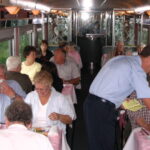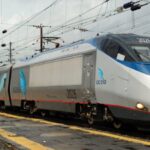NARP: Promoting Rail is an Uphill Challenge.
Improving our national passenger rail system is the mission of the National Association of Railroad Passengers. And, let me tell you, in this day and time, and under the current political conditions, it’s a tough slog.
It’s very difficult to gain any ground using rational arguments supported by facts and figures if you’re trying to win over a member of Congress who is philosophically opposed to the idea that every citizen has a fundamental right of access to public transportation at an affordable cost. And as far as trying the “benefits to the environment” argument … well, best not to go there at all.
This country’s transportation infrastructure is barely adequate now and could actually collapse under the weight of a constantly-increasing population. It’s going to take many billions of dollars to address the problem, but when you point that out, they look at you and say, “But we can’t afford it.”
Much of the problem is the result of the “dumbing down” of the general public from the sorry state of our news media. We rarely get any in-depth reporting of truly important issues. Instead, we’re subjected to the If-It-Bleeds-It-Leads school of journalism. The news we do get is superficial, largely irrelevant, and there’s a lot less of it. What the media does deliver in large, loud doses is opinion. No wonder the electorate is largely and woefully uninformed. And mis-informed.
In particular, it has become more and more difficult to move public opinion when it comes to transportation issues. It’s a big, important and complicated subject, and that means it takes time to explain. There’s a lot to understand, a lot to digest. People have to pay attention. And actually think.
And so the challenge for those of us working through NARP for better and faster trains is finding a way to take a complex subject and present it in simple, easy-to-grasp bullet points. For example, critics keep referring to the annual $1.4 billion subsidy Amtrak gets from the federal government as though it were a massive, budget-busting amount. Here’s how we might put that number into some reasonable perspective for people.
– One-point-four billion? Just one major highway interchange in Milwaukee cost $1.7 billion.
– One-point-four billion? The U.S. donates more than that every year to the World Bank so it can loan money to foreign governments.
Still, it’s a challenge. Try getting someone who has never been on an Amtrak train to understand why high-speed rail is much faster than higher-speed rail. These days, that’s asking a lot.





Makes ya crazy, doesn’t it! I may have written about it before, but I’ll do another post on the subject in the next day or so … about an encounter one of our members had with a congressional aide.
When I hear the stupid arguement against Amtrak subsidies, I like to ask “How much money did Interstate 81 make last year? – let’s put tolls on it” or “I assume you would support adding the full cost of TSA, the FAA, airport infrastructure, etc. into your ticket price then since you are so anti-subsidies”. I wonder if Amtrak was an “agency” rather than a “company” if things would be easier. Probably not.